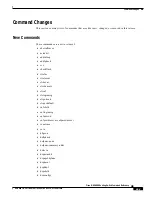
1-4
Cisco MGX 8850 Routing Switch Command Reference
Release 2.0, Part Number 78-10467-04 Rev C0, October 2001
Chapter 1
Command Line Interface Overview
Identifying the AXSM Models
•
The syntax of the command. This manual presents parameters in a column to make them easier to
read, particularly when displayed through an electronic medium.
•
A syntax description lists all the parameters. Each item in the list includes a brief definition,
functional details when appropriate, the range of values for the parameter, and an applicable default
value.
Note that, in many instances, the default value is not merely a basic starting value but rather the most
desirable or commonly used value.
•
Occasionally, the description includes a Usage Guidelines section when the complexity of the
command warrants it. The Usage Guidelines section contains important details about using the
command. When needed, an additional section with a specialized focus may appear. An example is
the Version Numbering description for the firmware upgrade commands (see loadrev, for example).
•
An Attributes section lists the following details:
•
Whether the switch logs each instance of command execution. Typically, the switch logs each
configuration change but no display commands.
•
The state of the card required to a execute a command. The state can be active, standby, initialized
(infrequently), or any of these states.
•
A Related Commands lists other commands in the typical grouping of commands (add, delete,
configure, and display) or other commands that could complement the command.
•
An Example section shows one or more examples of command usage. The text for this section
describes the intention of the command and may also describe an outcome. A representation of
screen output usually appears. Occasionally, supplemental commands and screen samples appear in
support of the example.
Identifying the AXSM Models
The model number of an AXSM identifies the line speed, line count, and number of bays (see
Table 1-1
.)
Note that the number of lines applies to an individual back card, so the total number of lines supported
by the front card equals the highest line number times the number of bays. The OC-48 card
AXSM-1-2488 has the lowest number of lines—one. The highest number of lines exist on the
AXSM-16-155 and AXSM-16-T3E3—16, as the name indicates.
The MGX 8850 node use
s
the concept of a bay. The bay refers to the upper or lower location of a
single-height card. (The switch has a double-height card cage, so a single-height back card necessarily
occupies either an upper or lower position.)
The T3/E3, OC-3, and OC-12 versions of the AXSM can have two back cards, one in bay 1 (upper
location of the back slot) and the second in bay 2 (lower slot). The MGX-AXSM-1-2488 (OC-48 AXSM)
can have a back card in bay 1 only. For further descriptions and illustrations of the card sets, refer to
Cisco MGX 8850 Hardware Installation, Release 2.
Table 1-1
Valid Line Numbers and Number of Bays for AXSM Card Types
Front Card
Speed
Lines
Bays
AXSM-1-2488
OC-48
1
1
AXSM-4-622
OC-12
1–4
1–2
AXSM-16-155
OC-3
1–8
1–2
AXSM-16-T3E3
T3, E3
1–8
1–2
















































